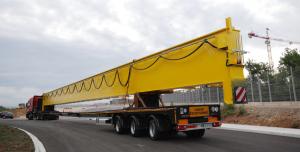Special delivery for ITER
Giant steel beams arrived at the ITER site this week after a two-week voyage from San-Sebastian, Spain on flatbed trucks. The beams will form the first of two bridge cranes that are planned for the Poloidal Field Coils Winding Facility.
The Winding Facility is the enormous building going up along the eastern side of the ITER platform that will house the assembly of the poloidal field coils. Five of the six poloidal field coils, measuring from 8 to 24 metres in diameter, are too massive to be transported in their finished state. The winding operations for these magnets will be carried out by Europe in the Poloidal Field Coil Winding Facility, using conductors supplied by China and Europe.
The heavy lifting required for coil assembly will be done by two bridge cranes. Straddling the workspace across its width (approximately 40 metres) and installed at opposite ends of the Winding Facility, the cranes will travel along metal rails that span the building's entire length.
Over the past days, the beams for the first crane—with a combined weight of 46 tonnes—were settled into place in the west part of the building some 9.50 metres overhead. Once secured, workers will lift the hoisting trolley into its final position and proceed with electrical connections and load testing. In all, the installation should take three weeks.




